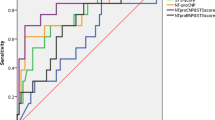Abstract
Patients with tetralogy of Fallot (TOF) after total correction usually have residual pulmonary regurgitation resulting in right ventricular (RV) dilatation and dysfunction. This study was performed to evaluate N-terminal pro-brain natriuretic peptide (NT-proBNP) in predicting RV dilatation and RV dysfunction in TOF after total correction. Twenty-one patients with TOF after total correction (12 males and 9 females, 12.06 ± 2.54 years old) underwent echocardiography, cardiac magnetic resonance imaging (MRI), and blood sampling for NT-proBNP. Mean time after total correction was 7.59 ± 2.30 years. From cardiac MRI study, mean right ventricular end diastolic volume index (RVEDVi) was 148.36 ± 64.50 ml/m2 and mean right ventricular ejection fraction (RVEF) was 35.50 ± 10.50%. Right ventricular dilatation was considered if RVEDVi was >108 ml/m2 and RV dysfunction was considered if RVEF was <40%. A plasma NT-proBNP level of 115 pg/ml was identified by receiver operating characteristic analysis in predicting RV dilatation and/or dysfunction. At this value, the sensitivity and specificity for predicting RV dilatation, RV dysfunction, and both RV dilatation and dysfunction were 71 and 100%, 71 and 71%, and 83 and 78%, respectively. In conclusion, plasma NT-proBNP level may be helpful in follow-up patients. Plasma NT-proBNP levels >115 pg/ml can be used as a marker in the detection of RV dilatation and dysfunction.






Similar content being viewed by others
References
Abd El Rahman MY, Abdul-Khaliq H, Vogel M, et al. (2000) Relation between right ventricular enlargement, QRS duration, and right ventricular function in patients with tetralogy of Fallot and pulmonary regurgitation after surgical repair. Heart 84:416–420
de Roos A, Roest AA (2000) Evaluation of congenital heart disease by magnetic resonance imaging. Eur Radiol 10:2–6
Helbing WA, de Roos A (1998) Optimal imaging in assessment of right ventricular function in tetralogy of Fallot with pulmonary regurgitation. Am J Cardiol 82:1561–1562
Helbing WA, de Roos A (2000) Clinical applications of cardiac magnetic resonance imaging after repair of tetralogy of Fallot. Pediatr Cardiol 21:70–79
Hosoda K, Nakao K, Mukoyama M, et al. (1991) Expression of brain natriuretic peptide gene in human heart. Production in the ventricle. Hypertension 17:1152–1155
Jauhiainen T, Jarvinen VM, Hekali PE (2002) Evaluation of methods for MR imaging of human right ventricular heart volumes and mass. Acta Radiol 43:587–592
Koch A, Singer H (2003) Normal values of B type natriuretic peptide in infants, children, and adolescents. Heart 89:875–878
Lang CC, Coutie WJ, Struthers AD, et al. (1992) Elevated levels of brain natriuretic peptide in acute hypoxaemic chronic obstructive pulmonary disease. Clin Sci (London) 83:529–533
Lethimonnier F, Furber A, Balzer P, et al. (1999) Global left ventricular cardiac function: comparison between magnetic resonance imaging, radionuclide angiography, and contrast angiography. Invest Radiol 34:199–203
Nagaya N, Nishikimi T, Okano Y, et al. (1998) Plasma brain natriuretic peptide levels increase in proportion to the extent of right ventricular dysfunction in pulmonary hypertension. J Am Coll Cardiol 31:202–208
Niezen RA, Helbing WA, van der Wall EE, et al. (1996) Biventricular systolic function and mass studied with MR imaging in children with pulmonary regurgitation after repair for tetralogy of Fallot. Radiology 201:135–140
Rominger MB, Bachmann GF, Pabst W, Rau WS (1999) Right ventricular volumes and ejection fraction with fast cine MR imaging in breath-hold technique: applicability, normal values from 52 volunteers, and evaluation of 325 adult cardiac patients. J Magn Reson Imaging 10:908–918
Suda K, Matsumura M, Matsumoto M (2003) Clinical implication of plasma natriuretic peptides in children with ventricular septal defect. Pediatr Int 45:249–254
Tulevski II, Groenink M, van Der Wall EE, et al. (2001) Increased brain and atrial natriuretic peptides in patients with chronic right ventricular pressure overload: correlation between plasma neurohormones and right ventricular dysfunction. Heart 86:27–30
Valsangiacomo-Büchel ER, Dave HH, Kellenberger CJ, et al. (2005) Remodeling of the right ventricle after early pulmonary valve replacement in children with repaired tetralogy of Fallot assessment by cardiovascular magnetic resonance. Eur Heart J 26:2721–2727
Wiesmann F, Frydrychowicz A, Rautenberg J, et al. (2002) Analysis of right ventricular function in healthy mice and a murine model of heart failure by in vivo MRI. Am J Physiol Heart Circ Physiol 283:H1065–H1071
Yasue H, Yoshimura M, Sumida H, et al. (1994) Localization and mechanism of secretion of B-type natriuretic peptide in comparison with those of A-type natriuretic peptide in normal subjects and patients with heart failure. Circulation 90:195–203
Yeo KT, Wu AH, Apple FS, et al. (2003) Multicenter evaluation of the Roche NT-proBNP assay and comparison to the Biosite Triage BNP assay. Clin Chim Acta 338:107–115
Acknowledgments
This study was supported by a research grant from the Faculty of Medicine, Ramathibodi Hospital, Mahidol University. We thank Dr. Chusak Okartchroen and Dr. Sangkae Chamnanwanakit for statistic consultation. We also that Roche Diagnostics for providing NT-proBNP reagents.
Author information
Authors and Affiliations
Corresponding author
Additional information
Presented at The Scientific Sessions, American Heart Association, Dallas, Texas, USA, November 2005.
Rights and permissions
About this article
Cite this article
Khositseth, A., Manop, J., Khowsathit, P. et al. N-Terminal Pro-Brain Natriuretic Peptide as a Marker in Follow-Up Patients with Tetralogy of Fallot After Total Correction. Pediatr Cardiol 28, 333–338 (2007). https://doi.org/10.1007/s00246-006-0170-5
Received:
Accepted:
Published:
Issue Date:
DOI: https://doi.org/10.1007/s00246-006-0170-5




